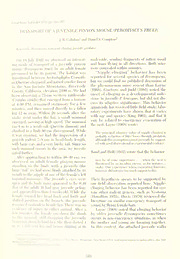
TRANSPORT OF A JUVENILE PINYON MOUSE (PEROMYSCUS TRUEI) PDF
Preview TRANSPORT OF A JUVENILE PINYON MOUSE (PEROMYSCUS TRUEI)
Grt-atBasinNaturalist53(3),pp.316-31" TRANSPORT OF AJUVENILE PINYON MOUSE {PEROMYSCUS TRUEI) |. R. Calhiliaii' and Daniel S. Compton- Kcijwords: Feroniyscus,transport,clinging,juvenile,predator. On 18 |uK 1992 we observed an interest- underside, sending fragments of rotten wood ing mode of transport of" a juvenile pinyon and loam flying in all directions. Both mice mouse {Peromysciis truei) by an adult female were concealed within minutes. presumed to be its parent. The habitat was "Nipple clinging" behavior has been transitional between ArctostapJujlos/Ceanoth- reported for several species of Peroinyscus, ii.s/Quercus chaparral and mixed conifer forest but we could find no published discussion of in the San Jacinto Mountains, Riverside the phenomenon more recent than Layne Count); California, elevation 2100 m. We had (1968). Guetzow and Judd (1981) noted the been observing a 75-cm western rattlesnake onset of clinging as a developmental mile- iCrotaliis liridis) that emerged from a burrow stone in juvenile P. leucopiis, but did not dis- at 4:30 PM, remained stationary for a few cuss its adaptive significance. This behavior minutes, and then moved directly to a fallen apparentlyhas received little field study; labo- log 12 m away. Within 20 seconds after the ratory experiments have shown that it varies snake went under the log, a small mammal with age and species (King 1963), and that it emerged, moving at high speed. The mammal may be related to emergency evacuation of ran H m to a scrub oak {Qitcrciis diiinosa) and the nest. Layne (1968) wrote: climl)cd to a limb 80 cm aboveground. While Tlir principal adaiitixe \alue of nippk- clinging is it was running, we had the impression of a prohabK reduction of litter losses through predation, grayish rodent 7-8 cm in head-bod\^ length, although thisassumptioncannotpresenth'besupport- with large ears and a xen buslu' tail. Since no edwithgoodohser\ationalorexperimentale\idence. such mammal occurs in the area, we investi- gated further. Rand and Holt (1942) wrote that the beha\ior i\fter approaching to within 30-40 cm, we observed an adult female pinyon mouse may he ot some importance . . . when the nest is standing on the limb, with a juvenile (the tsnharkeea.tenOeudrbeyxpaenriinevnacdeinwgheennemeyx,caavsatfiornginbsutranrcoew,s,i, large "tail" we had seen) firmly attached by its however,didnotgi\etoomuch supporttothis. mouth to the nipple ofone ofthe female's left inguinal mammae. The juvenile s eyes were Their hypothesis apears to be supported by open and its body mass appeared to be 0.40 our field observation reported here. Nipple- that of the adult. It had gray juvenile pelage clinging behavior has been reported for cer- and appeared less than 3 weeks old. While the tain other rodent genera, such as Ncotoma female turned her head back and forth and (Hamilton 1953). Davis (1970) reviewed the shifted position on the branch, the juvenile literatin-e on similar emergenc\' transport of remained motionless beside her. There was no \oungby flying female bats. evidence of injury to either animal. After a Layne (1968) noted that clinging beha\ior few minutes, the female ran down the shrub b\ older juvenile Perotnysciis sometimes to the ground, still dragging the juvenile occius in non-emergenc>' situations, as when bouncing along behind her. She then darted 4 the mother and \()ung are foraging together. m to a different log and began digging at its In this context, the attached juvenile walks 'MnsniniofS.)i,tli«,-sl.-ni Biologx. liiiM-rsilvof\c« Mixico..\ll)iu|U.n|ii,-, NewMi-xicoS7131. Siuclnpriiit iiuesistoin.iilm,s.idcin-.^s: Bo.\3140, llenifl.CalifonihiU2.5-46. 2ldyll«-iMSchool.l.l\MuiKl,California92.549. 316 1993] Notes 317 beliind the female rather than heiii<2; chati^ed Li KKATl HK C:iTK15 I along. This hehaxior nia\ explain the follow- ing related ohsenation. Between 30 Jnne and D.wis, H. 1970. (,'arniniioi \()imiihy iUiimIiukiIc NOrlli 10July 1992 we conducted a niark-and-recap- .\nuMican l)ats. .AiiuMitaii Micllaiu! Naturalist 8.}: lS(i-196. ture study of small mammals in Rixersidean GrETZOW, ID. D., and F. \V. jini). 1981. Postnatal sage scrub and alluvial scrub habitat just growthanddcxflopnientinasubtropicalpopulation south of Highland, San Bernardino C^ountw ofPeroinijsni.s h'uvopus texamts. SoutliwcslcTn .Nat- California. One 9-inch folding Sherman trap uralist26: 18.3-191. w{Paesrofnoiyusncdiitsoccroenitnaiicuns)t:woa d3-eatdo c4a-cwteuesk-luoilcde lIwiijtLloTiuOcrNn,FalloWro.ifdjMa.a.wnIioIuIo.ida1l9roa5gt3y,.3X4Re:to-t1po8ii0on-da1u8cf9t.i.jolnuahnddumyiou(nOrgd)o.f juvenile whose neck had been caught in the Ki\<;.J.A. 19(i3. Matt-rnalhcliaxiorinPi'rouiijscus. Pages trap door, with its head inside the trap and the .58-93in W. L. Rlicingold,cd., .MatiMualIx'haviorin body hanging outside; and a lactating adult mammals,jolm\\ik'\ 6cSons Inc., NewYork. female, with one foot caught under the treadle LavnkK.inJg.,Ne.d.,19B6i8ol.ogO\n-tooigPecnrya.mijPsacguess(R1o4d8en-t2i5a3).iAnmJe.ri.\-. and some caked blood on its venter. The adult can Societyof.Mannnalogists, Special Publication2. was a recapture from the previous night; the Hand. \. L., and P. Host. 1942. .Mammal notes from juvenile was not marked. The most likely sce- Highland Counh-. Florida. Results ofthe .\rchl)old E.\i)editions, No. 45. Bulletin of the .American nario is that the juvenile was clinging to the MuseumofNatural History80: 1-21. female's nipple when she entered the trap. Sl.\l)E, N. a., M. .v. En-LKR, N. M. Gkit:Mi.u;i;\, ano The door apparentb' then sUuumed shut on A. L. D.wiiLOS. 1993. Differential effectiveness of the juvenile s neck, tearing it off the female. sstmaanldlarmdaamnmdallosn.g SJhoeurrnmaaln loifxetMraapmsmianlcoagptvur7i4n:g The use oflonger Shennan traps (Slade et al. 156-161. 1993) is recommended to reduce the inci- dence of this and other categories of trap Received9Soienihcr1992 injiuy AcceptedII Man-It 1993
